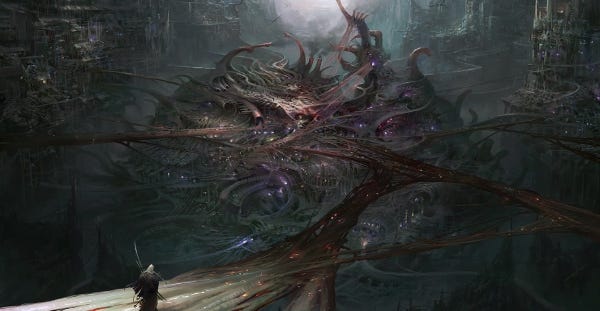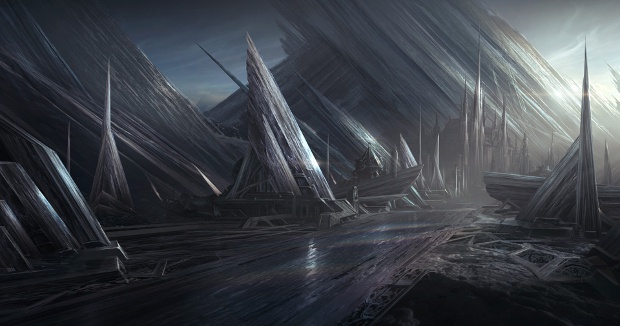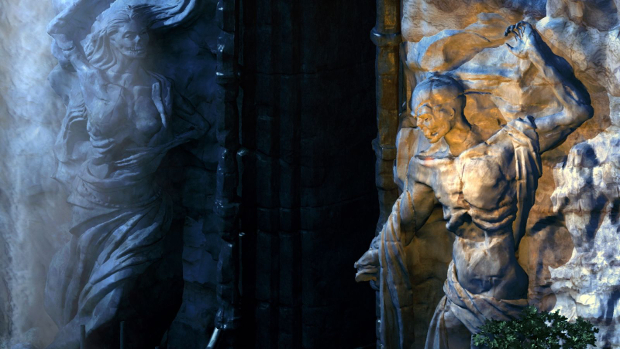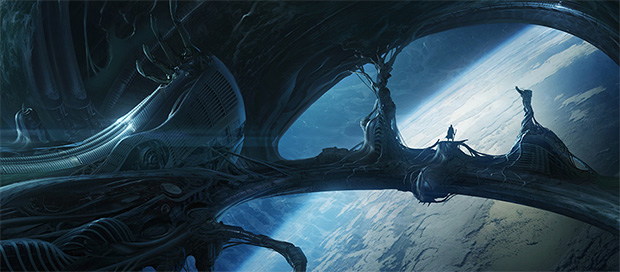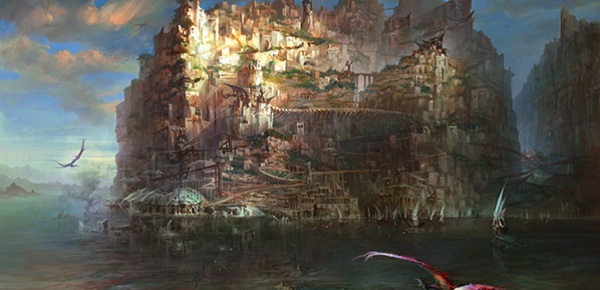The Ultimate Torment Interview Of Ultimate Torment, Pt 1
On Changes, Combat, And Quality Over Length
Madly anticipated Planescape Torment spiritual successor Torment: Tides of Numenera has been delayed. We won't be able to probe its strange, sloughing depths until late 2015, which is a shame except that if inXile released when they were originally planning to we'd probably get a stack of concept art and a mountain of design documents instead of a game. Torment's Kickstarter wrapped up more than a year ago, though, and it has made progress. Big progress. I spoke with project lead Kevin Saunders, creative lead Colin McComb, design lead Adam Heine, and new lead area designer George Ziets about how the game has evolved. In part one, we discuss combat, how backers have influenced the game, using Pillars of Eternity tech, why Torment will be more about quality than size, skill systems, and story changes. It's all below.
RPS: It's been more than a year since Torment's Kickstarter wrapped up. What's the pre-production process been like? How do you sit down and design a game like this? What do you prioritize?
Saunders: It’s been a combination of defining the breadth of the game at increasing levels of detail, while also delving into the very specifics for the most critical or risky elements. One aspect we prioritized early was the conversations. Adam Heine and Colin McComb were writing dialogue for the game soon after the Kickstarter campaign ended. We wanted to establish how we’d tell the story and imbue our conversations with as much reactivity as possible without making them prohibitively time-consuming to design and write.
Establishing our conventions for conversation design, and having in-game examples of them, was especially important given our host of writing talent.
Last summer, one of the systems Adam was working on was crafting. At that time, most of our design documentation was at a fairly high level, but Adam had some specific inspiration and thoughts about how crafting might work. So he ran with it, diving into a much deeper level of detail than most of our design at that time. Crafting touches many other aspects of the design: items, character abilities, loot and advancement, etc. Determining the details of that one system helped inform parts of many other systems, providing obvious answers for other design decisions and propelling our understanding of the game forward.
This is illustrative of our general approach – charging into the details whenever those are clear, and favoring this depth over the broad strokes. Right now, for example, we don’t have the specifics of every area in the game planned out. (Even so, we have written over 200K words of area design documentation.) Instead, we’ve brought the design of one major section of the game to considerable detail and are focusing energy on implementing and iterating on it so that we can learn more about the specifics and thus get closer to our target when we do turn our attention to other areas.
RPS: How did you originally conceive the game when you first kicked off the Kickstarter, and what has it evolved into since then? How has it changed? Why?
Saunders: It all began with Colin McComb’s story, many elements of which predated any thoughts of a Torment Kickstarter. Then, in the very early stages of planning the campaign, Colin brought in Adam Heine and more aspects of the story were fleshed out, such as the consciousness-hopping events that eventually became the Meres. Then we licensed Numenera from Monte Cook, developed the concept of the Tides - they were not initially a central part of the concept - and it all flowed from there.
We spent a lot of time before the Kickstarter establishing our core vision for the game and, for the most part, how it’s evolved over time has been more about fleshing out details than making changes.
RPS: How many major decisions have you made based on fan feedback?
Saunders: Backer feedback has influenced our design, but no major decision has yet been completely driven by the fans. Our decision for turn-based combat was something that we ran by the fans, but that was a bit different. We peruse the ideas submitted through UserVoice and, though our replies there are short, we take fans’ thoughts into account as we approach the design of each new element.
Much of this influence is invisible, behind the scenes. For example, through posts across various forums, interview questions, and the like, the desire for less linearity in gameplay became evident. While we’re still emphasizing the story-driven experience, we’ve found ways to loosen the reins through some portions of the game to provide more of the freedom we’re detecting TTON’s players would appreciate, without compromising the rich, story-driven experience we described in our vision.
Our supporters helped us even before the Kickstarter, where we sought input from them as to how to structure and present our campaign and reward tiers. Their suggestions have served us well and we’ll continue to pay attention to them.
RPS: Were there any points where you were tempted to change something based on especially boisterous feedback, but decided not to because of faith in your own design/understanding of said design?
Saunders: With the notable exception of the combat system, we haven’t been met with boisterous opposition to any aspects of the design that we’ve presented. There have been some times where feedback to a specific Kickstarter update raises our awareness of a particular issue, but these have been about details and nothing that disrupts the design. We’ve usually been pretty careful about what we discuss, only revealing aspects that have been percolating for a while and that we have some confidence in. At any point in time, there are some aspects of the design that are less solid and that would perhaps invite boisterous feedback. On a couple occasions we’ve thrown out some of these more speculative ideas, but they’ve been received fairly well.
I anticipate that we’ll see stronger opinions many months from now -- after we have some screenshots or even gameplay footage to show. So I’ll probably have a more interesting answer to this question in the future. Games can be very complicated and we certainly don’t always get it right. If some aspect of our design is harshly criticized, then even if we have complete confidence in it, we’ve at least blundered our presentation of it. So in that situation, there’s at least some iteration that’s needed. But it’s important to not be led astray by a vocal minority.
RPS: You've licensed Obsidian's Pillars of Eternity tech, which is obviously being used to great effect on Pillars. How well does it adapt to the more outlandish environments of a Torment game, though? Has it been a good fit so far? Have you run up against any unexpected challenges in testing it out?
Saunders: The technology has been a good fit, but the approach itself is challenging in terms of scope. Creating the 2D prerendered environments is labor intensive. In game development, we’re typically using whatever tricks we can to craftily reuse art to save work without diminishing the player experience. Numenera’s Ninth World craves uniqueness and weirdness and is not super cooperative with these tricks. Portraying the setting as we would like is very effort intensive. It’s the typical quality vs. quantity tradeoff. The setting is demanding that quality be favored, but it’s not specifically a technology matter.
And in general, we’re focusing in quality over quantity - handcrafted crises and a dearth of filler combat - so the challenges are at least consistent.
RPS: You're developing Wasteland 2 right now and then moving a lot of people over into Torment production after that. What have you learned from Wasteland 2 - especially now that it's so far along - that you can apply to Torment? Which specific things? What lesson surprised you the most?
Saunders: The entire Early Access process has been fascinating. Early in my career, I worked on MMOs - Nexus: The Kingdom of the Winds and Shattered Galaxy - and working with a community and beta testers was a major aspect of the games’ developments. But Wasteland 2 is the first time I’ve seen it with a single player RPG. One of the greatest values has been learning what the players don’t care about. It became clear through player comments (or lack of comments) that some aspects that we planned to expand or modify weren’t important to the players, allowing those resources to be invested in something else. Wasteland 2’s development has reinforced the importance of iteration, especially for RPG content that reacts to player decisions – it takes time to flesh out all of the reactivity that players might expect to result from their choices.
For Torment, which is more story-driven than Wasteland 2, I think we will share less of the game in advance than Wasteland 2 did, but I do want to get certain pieces out to our Alpha testers sooner rather than later (though still months away). For example, I’d like to share the opening conversation to see how it serves as an introduction to the game and world. And I want to get players’ opinion on some aspects of Crisis gameplay after it’s polished enough to generate useful critique.
RPS: Can you explain Numenera's skill system? It sounds fairly atypical in the grand scheme of CRPGs, but also rather versatile.
Heine: The Numenera skill system is atypical in that any character can attempt any task, and for moderately difficult tasks, even an untrained character can succeed for a cost. This is extremely versatile. We can worry less about whether certain character builds can pass obstacles or not—they all can; it's just a matter of how much it will cost them.
Say the ancient ruins you're exploring are trapped by a complicated prior world detonator. To disable this thing would be a difficulty 6 task, which on the Numenera scale is very hard - an untrained character could only succeed about 15% of the time. Training in any skills that apply will lower this difficulty up to two steps per applicable skill. So someone specialized in, say, Lore: Machinery would attempt the task as a difficult 4, with a 45% change of succeeding.
Additionally, there's the concept of Effort, where you can spend points from the appropriate Stat Pool (in this case, Speed) to lower the difficulty even further. An untrained character of a high enough level could spend points to use 4 levels of Effort, reducing the difficulty to 2 and giving themselves an 85% chance of success. And if our specialized character did the same thing, they'd reduce the difficulty to 0. When this happens, the task automatically succeeds—no roll is made and there is no chance for critical failure.
It is tempting, especially given the worldview of typical skill-use in RPGs, to think that skills aren't very important - anybody can succeed at anything if they're willing to spend the points to do so. While it's true that skills aren't as important in Numenera as in typical RPGs, they are still very important. First, they save the PC's Stat Pool points: easy and moderate tasks cost the trained character nothing while succeeding more consistently than for the untrained character. Second, Numenera difficulties range from 1 to 10, and everything above difficulty 7 is impossible without training or Effort. A high-level character, purchasing the maximum amount of Effort, can reduce a difficulty 10 task to 4. For the high cost of all that Effort, they will still fail more than half the time. But the cost and risk for a trained character are greatly reduced.
RPS: You decided to make some pretty big changes to the game's story. Without spoiling too much, what was it like initially? What did you decide needed changing?
Saunders: Despite the major changes we’ve made to the story over the last year, what we said about the overarching story during the Kickstarter is still accurate. Perhaps today’s synopsis of the story would emphasize some different elements, but the premise and flavor are the same. Some of the finest details are, too - though most of what we revealed during the Kickstarter is uncovered by the player in the first 10% or so of the game anyway – we want to make sure our backers have plenty of surprises. Colin had strong core ideas; he has a story he wants to tell and that hasn’t changed.
But in our efforts to achieve the player experience he’s envisioning, we’ve adjusted some of the specifics of how the story unfolds – how and when the PC learns various pieces of it, for example. Chris Avellone, George Zeits, and Nathan Long all provided input here, which Adam, Colin, and I (mostly Colin) used in figuring out how to enhance the flow of the narrative. One aspect we spent considerable energy on was detailing the motivations of the various characters, including the PC. We challenged the “why” behind people taking certain actions and looked for ways to improve the pacing through the PC’s own motivations.
RPS: What will your story design process be like once you enter production? How closely will designers and writers be working together? Also, since it's such a small team, will many people be wearing design and writing hats?
Ziets: From our perspective, story or narrative design can mean a few different things. First, there’s the main story of the game, which has already been written by our narrative lead, Colin McComb. This may sound obvious, but it’s incredibly important to mostly finalize your main story and central themes before you start designing the rest of the game – you’d think that would always be the case in CRPG development, but it isn’t. Minor elements will always shift around as production moves forward, but with a solid story in place, a design team has a unified vision of the game they’re making and what themes to address in their content, which goes a long way toward making a game that feels like a coherent whole.
Second, there’s the high-level story in each of our zones. In other words – what’s happening in the zone, what goals the player needs to accomplish, who the major characters are, etc. That part of our story design is either finished (e.g., for the Bloom, a zone I designed earlier this year) or currently in development. Our goal is to have all the zone-level narrative design finished before we enter production, so that we can jump straight into implementation.
That leaves the final piece of narrative design – writing all the dialogue and implementing the quests – which will occupy us throughout production. Most of the zones are being designed at a high level by our off-site writers. Once the zone designs are completed and approved, they’ll be handed off to our in-house area design team for implementation. While the area designers are busy building the levels and scripting the gameplay, the writers will generate dialogue for their zones. This means that our writers and area designers will be working very closely together, bouncing ideas off one another, and ensuring that both narrative and gameplay elements are fun for players.
In practice, the roles of writer and area designer will blur together somewhat. Because most of our writers are offsite, they don’t have access to the level design tools, but lead designer Adam Heine is an (awesome) exception – he designed our very first level from scratch, wrote all the dialogue, and also worked on its implementation in the tool. Similarly, some of our on-site area designers have showed an interest in writing, so we’ll definitely want to give them a chance to do that, in addition to laying out levels and implementing our gameplay content. And as lead area designer, I’ll be doing a little of everything.
The Bloom zone is an example of how collaborative the process is likely to be. I did the high-level design, some of the combat/Crisis design, and I’ll be writing some dialogue. Jesse Farrell has been doing most of the implementation, but he’s also been coming up with great ideas to expand and improve the zone, and he’ll probably write some dialogue, too. And a bunch of other people - Adam, Colin, and gung-ho line producer Thomas Beekers - will also be contributing to the writing effort.
RPS: One area where you've gone off the road paved by Planescape is combat. You're opting for turn-based even though PST was real-time with pause. What kind of turn-based combat are we talking, though? How intricate will it be? What are your main influences on that front? Which other turn-based games?
Heine: Combat was one of those things in Planescape that many felt was lacking. We had plans to greatly improve it from the beginning, and as those plans solidified over the months after the Kickstarter, we saw how a turn-based system was better suited for them - especially the Crisis plan. Wasteland 2 designer Jeremy Kopman built a Crisis prototype based upon Wasteland 2, that proved the concept would work. At that point, we favored turn-based combat internally, but we wanted to know how the backers would feel about the shift from RTwP to TB. So we explained our thoughts to the backers, asked for discussion, and put it to a vote. Both the vote and the discussions were split right down the middle.
But those discussions have helped clarify and solidify our ideas. We learned what people don't like about turn-based combat and come up with ways to address those issues. In many cases, our existing plans had addressed those issues before the backers even raised them, which was very encouraging.
We have a lot of influences for turn-based. One that stands out is Temple of Elemental Evil. I hadn't played this game before the combat vote, but as soon as I did I knew this was a good foundation for Torment. Specifically the way they handled gridless turn-based, move vs. attack actions, and a wealth of tactical choices for the player. The Fire Emblem games have been another formative influence for Crises in general, specifically the idea of goals and actions beyond just "kill the other guy." While you can certainly fight your way through most Crises, players will frequently have other options as well, like interacting with the environment to use it to your advantage, talking to NPCs to persuade them to help you, etc. And of course we're learning a lot from Wasteland 2 and the feedback that project has received regarding pure tactical combat.
Check back soon for part two, in which we discuss deviating from Planescape Torment's design, why you won't be able to engage in combat anywhere/with anybody, party members, living up to expectations, subverting tropes (and when archetypes can actually be good), area design, and the delay. Also my final question goes unanswered because it is dumb.
